| Botanical Name |
|
| Family |
Rubiaceae - The gardenia and coffee family. |
| Pronunciation |
bur-CHEL-lee-a bub-uh-LEE-nuh |
| Common Name(s) |
English: Wild pomegranate
Afrikaans: Wildegranaat; Buffelshoring
IsiZulu: isiGolwane; Uqongqo; Utshwalabenyoni
|
| Plant Group |
- Shrub A woody plant of relatively low height, having several stems arising from the base and lacking a single trunk; a bush.
|
| Plant Size |
- Very large
| Tree | Over 25m |
| Shrub | Over 4m |
| Perennial/ground cover | Over 1m |
| Bulb | Over 1.2m |
| Succulent | 1.5m to 2m |
- Small
| Tree | 4m to 8m |
| Shrub | 50cm to 75cm |
| Perennial/ground cover | 10cm to 20cm |
| Bulb | 20cm to 30cm |
| Succulent | 10cm to 20cm |
|
| Position |
- Canopy Shade Canopy shade is found below closely grown trees where some light filters through. Ideal for the protection of herbaceous plants.
- Deep / Full Shade Shade below spreading evergreen trees where sun's rays are unable to penetrate the canopy at any time. For light sensitive plants
- Dry Shade Shady areas where soil has poor water retention or are dependent on rain for their moisture needs.
- Light or Dappled Shade Found below trees with sparse, open foliage. Ideal for the protection of herbaceous plants.
- Partial Shade The area is in shade for part of the day and in full sun for part of the day.
- Sun The area is in full sun for all or most of the day, all year round.
|
| General Information |
- Drought Tolerance: High The plant is well adapted to arid conditions; it can survive long periods of drought and high temperatures without extra water.
- Evergreen Plants that have leaves all year round.
- Frost: Half-hardy The plant is able to survive low temperatures and some frost but requires protection against severe frost.
- Water Wise Plant species originating from low rainfall regions that require less water to survive and thrive than other plant species.
- Wind Tolerant Plants able to withstand the effect of strong winds.
|
| Specific Information |
Burchellia bubalina flowers best in full sun but will also thrive in deep shade. The Wild pomegranate in flower makes an attractive contrast of dark green leaves and bright red flowers. This species is not related to the true pomegranate. The common name refers to its initial resemblance, when in flower, to the true pomegranate.
|
| Ad Break |
|
| Flowers |
| Description |
urn shaped in small dense clusters
|
| Season |
- Spring to Summer Plants will seldom bloom for the entire season as given in the list, but should flower during a period within these parameters.
|
| Colour |
|
| Growth Rate |
- Moderate to Fast Specifying growth rate can be very misleading as there is considerable variation of growth rate depending on type and species of plant, available water, supplementary feeding, mulching and general care, as well as the plants suitability and adaptability to the garden environment.
|
| Plant Uses |
- Accent or Focal Point A plant used to attract the attention because of its colour or form.
- Attracts bees, butterflies or other insects This plant attracts insects which can be food for birds or other creatures in your garden.
- Attracts Birds This plant will attract birds.
- Boundary A plant useful for planting around the edges of the property to form a green or colourful backdrop, an impenetrable hedge, to hide walls or create privacy.
- Container Trees, shrubs and ornamental species that can adapt to growing in a restricted environment.
- Filler Either a fast growing tree or shrub used temporarily to fill in an area while the permanent plants grow to a desired size, or a plant used to fill gaps in borders or beds.
- Hedge Suitable trees or shrubs planted relatively close together so that the branches intertwine to create a barrier. This can be formal – the plants are regularly trimmed to produce a neat shape, or informal – the plants are left to themselves to create a natural hedgerow.
- Provides light / dappled shade A tree with an open to sparse canopy, through which varying degrees of sunlight can penetrate.
- Rock Garden An area constructed of larger rocks, arranged naturally, to emphasise the use of stones as a main element. Generally plants used do not need a lot of care.
- Suitable for coastal gardens Plants adapted to dry, sandy soil, forceful wind, limited rainfall and intense sunlight.
- Suitable for smaller gardens Such plants do not have invasive root systems, remain small or controllable and can often be grown in containers.
- Wild Garden An indigenous garden planted for the benefit of wildlife and birds. Provides food, water, a variety of mini-biomes and no poisonous chemicals are used.
|
| Distribution and Habitat |
from Swellendam in the Western Cape to the Eastern Cape, KwaZulu-Natal, Mpumalanga and Limpopo, in forests, along forest margins, on rocky outcrops and in bush clumps in montane grasslands
|
| Planting Suggestions |
When planted out, Burchellia bubalina initially prefers rich loam soil, with the addition of some compost and a good layer or mulch. Young plants must be protected from frost.
|
| Medicinal Uses |
The roots are used as an emetic to cleanse the body. Roots are also used in conjunction with other plant parts to concoct a love charm.
|
| Ad Break |
|


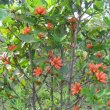
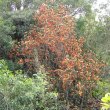
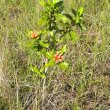
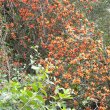
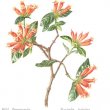


Comments
HI
HI
Could you please tell me what type of fertilizer does this plant prefer?
Fertilizing Burchellia bubalina
Hi Hamed
This species has no special needs that I know of, so a good choice would be a general fertilizer of the slow release, organic variety. We have had good results from Bounceback but there are others to choose from. Your local nursery, hardware or garden centre should be able to help you.
Just a word of warning: The wild plants in the area are subject to frequent droughts and the soil in the Albany area is known to be lacking in nutrients. These wild plants are densely covered in flowers, while those in more fertile soil have plenty of healthy leaf growth but fewer flowers. (Compare the plants in the first two photos above.) It is best to use fertilisers according to the instructions - don't be tempted to over-fertilize.
Hope this gives you some guidance.
Kind regards
Lorraine
Discuss this plant
Share knowledge, ask a question or give an experience.